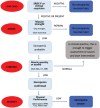Effects of hormonal changes on sarcopenia in chronic kidney disease: where are we now and what can we do?
- PMID: 34676694
- PMCID: PMC8718043
- DOI: 10.1002/jcsm.12839
Effects of hormonal changes on sarcopenia in chronic kidney disease: where are we now and what can we do?
Abstract
Sarcopenia or muscle wasting is a progressive and generalized skeletal muscle disorder involving the accelerated loss of muscle mass and function, often associated with muscle weakness (dynapenia) and frailty. Whereas primary sarcopenia is related to ageing, secondary sarcopenia happens independent of age in the context of chronic disease states such as chronic kidney disease (CKD). Sarcopenia has become a major focus of research and public policy debate due to its impact on patient's health-related quality of life, health-care expenditure, morbidity, and mortality. The development of sarcopenia in patients with CKD is multifactorial and it may occur independently of weight loss or cachexia including under obese sarcopenia. Hormonal imbalances can facilitate the development of sarcopenia in the general population and is a common finding in CKD. Hormones that may influence the development of sarcopenia are testosterone, growth hormone, insulin, thyroid hormones, and vitamin D. Although the relationship between free testosterone level that is low in uraemic patients and sarcopenia in CKD is not well-defined, functional improvement may be seen. Unlike testosterone, it is known that vitamin D is associated with muscle strength, muscle size, and physical performance in patients with CKD. Outcomes after vitamin D replacement therapy are still controversial. The half-life of growth hormone (GH) is prolonged in patients with CKD. Besides, IGF-1 levels are normal in patients with Stage 4 CKD-a minimal reduction is seen in the end-stage renal disease. Unresponsiveness or resistance of IGF-1 and changes in the GH/IGF-1 axis are the main causes of sarcopenia in CKD. Low serum T3 level is frequent in CKD, but the net effect on sarcopenia is not well-studied. CKD patients develop insulin resistance (IR) from the earliest period even before GFR decline begins. IR reduces glucose utilization as an energy source by hepatic gluconeogenesis, decreasing muscle glucose uptake, impairing intracellular glucose metabolism. This cascade results in muscle protein breakdown. IR and sarcopenia might also be a new pathway for targeting. Ghrelin, oestrogen, cortisol, and dehydroepiandrosterone may be other players in the setting of sarcopenia. In this review, we mainly examine the effects of hormonal changes on the occurrence of sarcopenia in patients with CKD via the available data.
Keywords: COVID-19; Cachexia; Chronic kidney disease; Hormones; Sarcopenia.
© 2021 The Authors. Journal of Cachexia, Sarcopenia and Muscle published by John Wiley & Sons Ltd on behalf of Society on Sarcopenia, Cachexia and Wasting Disorders.
Conflict of interest statement
S. D. A. reports receiving fees from Abbott, Bayer, Boehringer Ingelheim, Cardiac Dimension, Cordio, Impulse Dynamics, Novartis, Occlutech, Servier, and Vifor Pharma, and grant support from Abbott and Vifor Pharma. K. K. Z. has received honoraria and/or support from Abbott, AbbVie, ACI Clinical (Cara Therapeutics), Akebia, Alexion, Amgen, Ardelyx, Astra‐Zeneca, Aveo, BBraun, Chugai, Cytokinetics, Daiichi, DaVita, Fresenius, Genentech, Haymarket Media, Hospira, Kabi, Keryx, Kissei, Novartis, Pfizer, Regulus, Relypsa, Resverlogix, Sandoz, Sanofi, Shire, Vifor, UpToDate, and ZS Pharma. Other authors have no competing interests to declare.
Figures





References
-
- Rosenberg IH. Symposium: sarcopenia: diagnosis and mechanisms sarcopenia: origins and clinical relevance. J Nutr. 1997;127:990–991. - PubMed
Publication types
MeSH terms
LinkOut - more resources
Full Text Sources
Medical
Miscellaneous

